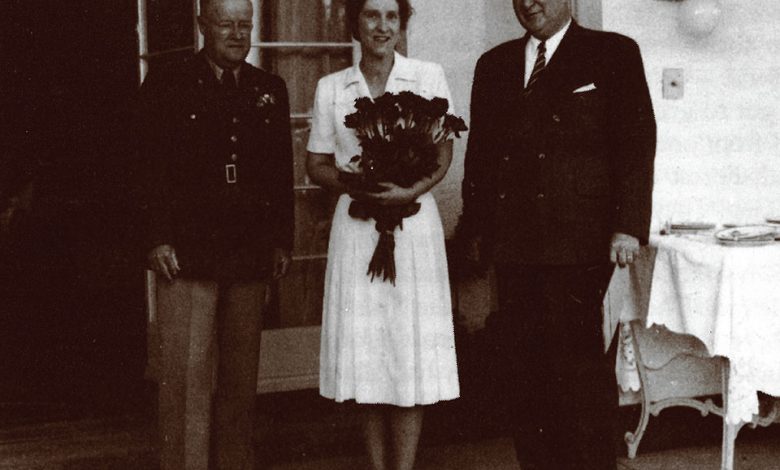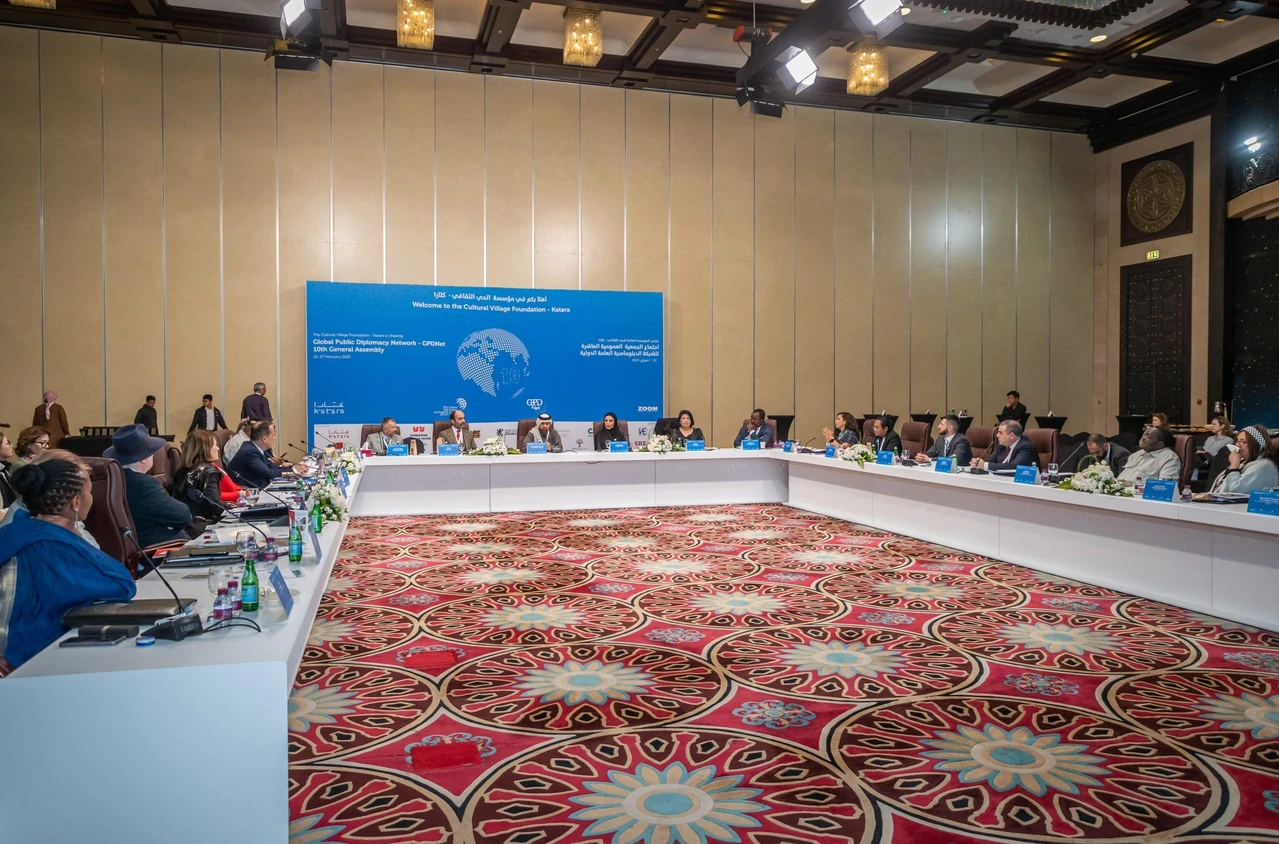Constance Harvey, the Medal of Liberty and the Valor of a Diplomat in World War II

Being a diplomat can mean putting yourself at risk, especially in times of violence or war. Diplomats can help evacuate their country’s citizens from dangerous situations or stay in touch with political factions or groups to help understand a changing political situation.
Constance Ray Harvey, one of the first women to become a Foreign Service officer, volunteered to put herself in danger while serving as a diplomat in France during World War II. For her outstanding efforts, she received the Medal of Freedom – the predecessor of today’s Presidential Medal of Freedom.
The National Museum of American Diplomacy recently added Constance Harvey’s Medal of Freedom to its permanent collection. The museum’s collection already included other personal items, such as military dog tags she wore while serving in Europe and her Phi Beta Kappa pin.
What exactly did Constance Harvey do to receive the Medal of Freedom?
Constance Harvey’s Medal of Freedom. Collection of the National Museum of American Diplomacy; Gift of the Association for Diplomatic Studies and Training (ADST).

Dog tags issued to Constance Harvey during her service in Europe, probably in early 1945 when she was posted to Zurich, Switzerland during the war. “T-44” indicates that she was vaccinated against tetanus in 1944. Collection of the National Museum of American Diplomacy; Gift of the Association for Diplomatic Studies and Training (ADST).
A new post in Vichy France
In January 1941, the US State Department transferred Constance Harvey from Bern, Switzerland, to the US Consulate in Lyon, France, as Deputy Consul.
France had fallen under German Nazi control in June 1940, but under the terms of the armistice there were two zones: one under German military occupation and one that was nominally a free French state. This became known as Vichy France, and Lyon was within its borders.
From the beginning of her time in Lyon, Harvey kept in touch with General Barnwell Legge, the US military attaché still based in Bern. She had developed a strong friendship with Legge and his wife.
General Legge wasted no time in asking Harvey for her help. From her convenient location in Lyon and her official position, she would prove useful to the war effort, socializing, gathering information and even doing a bit of smuggling – all in the name of the broader Allied cause against Germany and the Axis powers.

General Barnwell Rhett Legge, to whom Constance Harvey relayed information while posted in Vichy France (US War Department archive photo)
“Up to a Monkey Deal”
Constance Harvey had no hesitation in answering General Legge’s request with an enthusiastic “yes”. As she recalled in her 1988 oral history, “I did a lot of business for our military attaché in Bern that didn’t go through the embassy in Vichy.”
This “deal” varied, according to Harvey’s recollections, but aided General Legge’s efforts to get useful information about the war raging in Europe from his post in neutral Switzerland to the War Department in Washington, DC
In Lyon, Harvey maintained important personal contacts in northern France, which was in the zone occupied by the German military. Her role as vice-consul gave her access to the official diplomatic briefcases, and she used them to secretly send information to Bern – sometimes by a courier, sometimes carried by herself – where General Legge received it.
Carrying the bag herself and traversing the 200 miles between Lyon and Bern, she would sometimes meet General Legge in Geneva, just over the French border and about halfway between Lyon and Bern.
On one of these occasions she handed over a copy of a map showing all German anti-aircraft stations around Paris – extremely valuable information. As she recalled, “He paled a little and said, ‘I’ll remember that!'”
Reflecting on receiving the Medal of Freedom in 1947 in her oral history, Harvey seemingly downplayed the importance of her role, remarking, “It was quite a few people [given the Medal of Freedom] who was up to some monkey business – just to help.”

Constance Ray Harvey after receiving the 1947 Medal of Freedom for her service in the French underground during World War II. At left is General Barnwell R. Legge, the US military attaché in Switzerland whom she was assisting. (Photo by Her Excellency by Ann Miller Morin, 1995)
“I know everything about you children, what you are up to.”
When Constance Harvey began helping General Legge in January 1941, the United States was officially a neutral country. Only with the attack on Pearl Harbor on December 7, 1941 would the country enter the war.
However, the United States had begun to transition from a position of neutrality to non-belligerence. As early as 1940, the United States began providing some form of assistance to the Allied nations in their struggle against Nazi Germany and the Axis powers.
Harvey’s support for General Legge was as an independent company for almost a year without the knowledge of her superiors. That changed shortly after the United States declared war.
In her oral history, Harvey recalled being summoned with a colleague to the office of her boss, the recently arrived Consul General in Lyon. “I know all about you kids, what you’re up to,” she recalled that he had told them. “You can take me on board now. We can share it together. I’ve been told what you do.”
Gestapo at the border
When Harvey made the journey to General Legge in Switzerland, she met French Vichy officials – and German Gestapo officials – at the border. Despite this, she managed to avoid capture. “I learned all the tricks. Everyone had to do it,” she recalled in her oral history.
One of those tricks was to use a quirk of the car she drove, a Ford. The car’s glove box, unlike other cars she’d driven, had a separate key that was only used for the glove box.
… When I got out to show my papers [customers officer], I would conspicuously dangle my keys in the ignition,” Harvey explained. “The other key [for the glove box] was down here around my neck under my dress.”
With the special glove box key safely hidden and the car’s other keys easily accessible in the ignition switch, the glove box worked to hide their contraband. “And I would go in [to talk to the customs officers] … and flew through.”
When asked by the oral history interviewer if she was frightened during her encounters with the Gestapo, Harvey said she was not. “You don’t have time,” she replied. “Besides, I was so fascinated; I was so interested, so determined to do it. Of course I was afraid in my life, but not to do something like that, not one bit.”
save a life
One of the most notable episodes of Constance Harvey’s time in Lyon occurred towards the end of her time there and exemplifies her personal character and determination.
With the Allied invasion of North Africa in early November 1942, Germany and the Axis powers moved into the military occupation of Vichy France and American diplomatic operations were no longer permitted.
Days before they were due to be taken into custody and interned by the Vichy authorities, one of Harvey’s colleagues, a Belgian national who had worked with her representing Belgian diplomatic interests, was dragged from his hospital bed by Vichy police and placed in a Train set to be taken to a concentration camp.
Harvey didn’t have it. She recalled telling her boss, “I have to go to the police. I’m going right now.” He told her there was nothing she could do, but she insisted that she had to try.
She spent about two hours arguing with an officer at the police station. She told him bluntly
I will not go into a comfortable, diplomatic internment and let this man go to a concentration camp. I do not take it.”
She refused to leave until he did something, but he didn’t move either. Finally, brought to tears by anger and frustration, she gave him an ultimatum:
“I said, ‘Look here. I went to school in France. France is a second country for me. If you don’t get this man back to the hospital to have his scheduled surgery, I’m going to spend the rest of my life working against France.'”
The officer gave in and picked up the phone to make a call. Ten minutes before the train was due to leave for the camp, Harvey’s Belgian colleague was pulled off and rescued. As Harvey recalled: “He would never have lived – he was in poor health anyway – there was no way he could have survived [a concentration camp].”
epilogue
In November 1942, Constance Harvey and her colleagues in Lyon were interned by the Vichy authorities and housed in hotels in Lourdes, France. Later, the Germans took her into custody and sent her to the German city of Baden-Baden. They were released in February 1944 and returned to the United States.
On an assignment in Washington, DC, Harvey learned that General Legge had earned a reputation in the government for being the best source of information on what was happening on the front lines of Germany’s fight against the Soviet Union. He had built an effective information network, and as Harvey recalled, “I was a part of it.”
Sources:
“Constance Ray Harvey”, The Association for Diplomatic Studies and Training Foreign Affairs Oral History Project, Women Ambassadors Series (1988)
“1940s – Diplomat and Heroine of World War II”, American Foreign Service Association (2014)
“Vichy France”, Brittanica
“1937-1945: Diplomacy and the Road to Another War,” Office of the Historian, US Department of State



